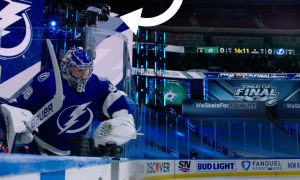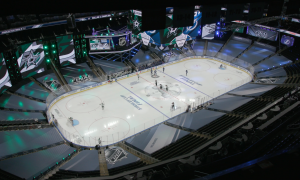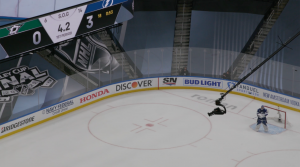Stanley Cup Final Caps Impressive NHL Broadcast Effort in Edmonton
Traditional compound layout supports broadcast teams from NBC Sports (U.S.), Rogers (Canada)
Story Highlights
With a pair of Stanley Cup Final games on the agenda for this weekend (Game 4 on Friday, Game 5 on Saturday, both 8 p.m. ET on NBC), the National Hockey League is drawing toward the conclusion of its grand “Hub Cities” experiment and, thus, the successful broadcasting of its playoff season under exceptional circumstances.
Since the start of the Conference Finals this month, the NHL “bubble” has been reduced to a single venue: Rogers Place in Edmonton, AB, and the hybrid onsite/”at-home” production model has continued to evolve.
With more resources centralized in a single location, the league has deployed new tools and services in support of its broadcast partners (NBC in the U.S., Rogers in Canada): additional onsite production facilities, more camera angles, and added graphic enhancements (including roll-out of the league’s highly anticipated puck- and player-tracking system).
“It has been a long, collaborative process with our television partners and all of our end units,” says Dan O’Neill, VP, arena and event operations, NHL. “The collaborative nature of working with the volume of entities and giving them the platform to do their business has been great.”
Condensed Compound, Limited Crews
The hybrid production model in Edmonton has led to a minor increase in the size of the production compound since the league left Toronto to finish out the playoffs in the single venue. The side-by-side lineup of three trucks comprises NEP Broadcasting’s ND5 (NBC Sports’ top hockey truck) and Dome Productions’ Silver (handling the major part of the game broadcast for Rogers and the world feed) and Unite (serving as a production B unit).
According to O’Neill, NBC Sports and Rogers are still producing the vast majority of their productions (graphics, audio mix, even on-air talent in some cases) from their respective home broadcast centers: Stamford, CT, and Toronto, respectively). However, NBC has nine or 10 crew members onsite working socially distant in ND5; Rogers has 12 or 13 crew members in its units.

More than 20 cameras are covering the action at Rogers Place in Edmonton, including five robotic cameras shooting in super-slo-mo, like this one positioned on the glass above the Tampa Bay Lighting bench.
O’Neill gives a nod to NHL Group VP, Broadcast Technology, Mark Haden, who played a critical role in coordinating the vast network of feeds and enhancements (data embedding, audio mapping, profanity-garbling systems with multiple feeds being delayed, puck/player tracking) for national and regional broadcasters dating back to the start of this effort back in June.
There is also a smattering of personnel onsite from other groups providing support, including SMT (which powers the puck- and player-tracking system and other virtual-graphics enhancements, such as dynamic statistical displays on the boards), WorldStage (the event-technology specialist assisting NHL Chief Content Officer Steve Mayer and his team in designing and building the in-arena structures that turned a hockey rink into essentially a television sound studio), and Cat Entertainment Services (providing power support not only for the compound but for the wide range of LEDs added to the arena’s staging).
Versatile Camera Arsenal
The NHL has been creative with camera deployment in Edmonton, having both expanded and enhanced its arsenal since the start of the Conference Finals.
The league has also relied on robotic cameras to add angles to the production without compromising personnel protocols. Currently, there are five robos on the rink, including one atop the glass of each end zone.
Providing Partners the Tools To Succeed
“How do we give [the networks] the opportunity to be creative on their own front, plus make it manageable,” says O’Neill. The league, he adds, put in the work to give them their own unilateral cameras, individual comms paths, and raw clock/score data feeds for the networks to design and build their own graphics packages. It also allowed each network to fax each aspect of the operation on their end on game days.


